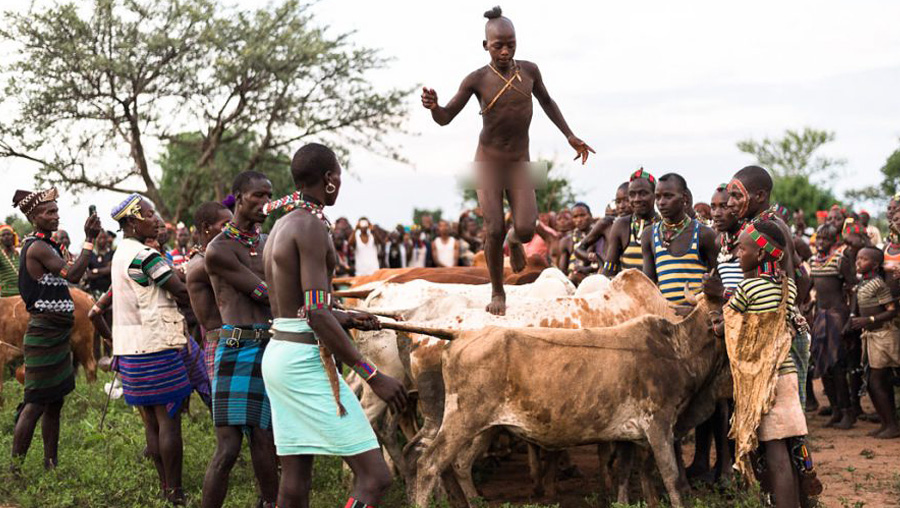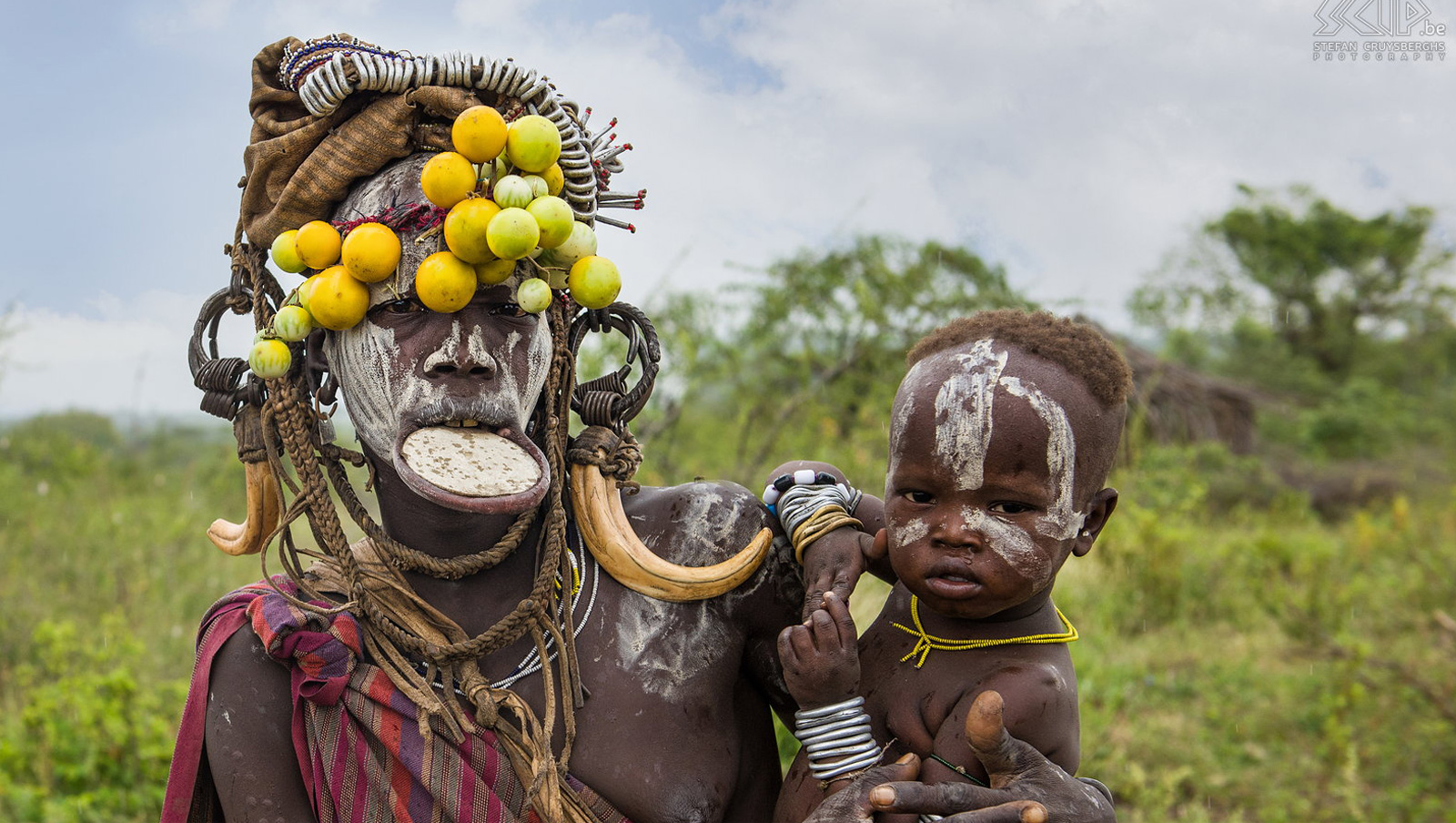People and Cultural Attractions in Ethiopia
Culturally the Southern Region is quite rich with some 45 Languages spoken by people of many different ethnic origins. These nations, from the many thousand-strong Borena to the just 1000-strong Karo, exhibit a fascinating range of cultural practices.
One notable cultural practice of these different groups of people is the way they build their houses. The Dorze, the Sidama and the Gurage in particular are known for their domed or beehive-like constructions that demonstrate the different uses of bamboo.
Just why there should be so many different people in such a relatively small patch of the earth is a matter of conjecture, but one probable reason may be the fact that that spot happens to be the place where peoples of four totally different cultural groups meet.
The Omo Valley is unique in that four of Africa’s major linguistic groups including the ‘endemic’ Omotic Languages are represented within one relatively small area.
To anthropologists, the Omo Valley is not far from being the proverbial ‘Living Museum’.
Following are some of the fascinating peoples and cultures:
When you tour the valley, about 16 tribes come into contact with you, some of them are : Arbore’s, Ari, Atse, Bena, Biraile, Bodi’s characterized by annual fatting ceremony, Daasanech (Geleb), Hamar’s with their Cattle Jump and Evangadi Dance , Karo’s Known by their body decoration, Kwegu, Maale, Mursi’s known with lip clay of women’s and Donga (stick) fighting for men’s, Tsemay, and Nyngatom.
These tribes have their own very distinct traditions and culture. These distinct traditions and cultural treasures include Oral traditions, Social practices, Ritual and Ceremonies, Knowledge and Practices concerning nature and the universe and Performing Arts.
The Dorze tribe: – A rich weaving tradition
 They are one of the small segments of the great Omotic language group of southern Ethiopia. Once warriors, they now earn their living by farming and weaving. The Dorze name is synonymous with the best in woven cotton cloth and the tall-up bee-hive shaped bamboo house. There is quite a big Dorze community living and weaving on the northern part of Addis, on the way to Entoto. These peoples rarely use the administrative and police force of the city. They settle all disputes in their usual cultural way, through their elders.
They are one of the small segments of the great Omotic language group of southern Ethiopia. Once warriors, they now earn their living by farming and weaving. The Dorze name is synonymous with the best in woven cotton cloth and the tall-up bee-hive shaped bamboo house. There is quite a big Dorze community living and weaving on the northern part of Addis, on the way to Entoto. These peoples rarely use the administrative and police force of the city. They settle all disputes in their usual cultural way, through their elders.
Konso: – People of Wooden-totem
 About 960 miles south west of Addis Ababa lies the widely cultivated Konso land that is embraced by Precambrian serpentines and granites. The Konso peoples speak eastern Cushitic language and are agriculturalists and weavers. These peoples are cryptic beyond visitors’ imagination which is demonstrated in the distinctive idealization of the figures and heroic lives of their deceased symbolized with wooden totem.
About 960 miles south west of Addis Ababa lies the widely cultivated Konso land that is embraced by Precambrian serpentines and granites. The Konso peoples speak eastern Cushitic language and are agriculturalists and weavers. These peoples are cryptic beyond visitors’ imagination which is demonstrated in the distinctive idealization of the figures and heroic lives of their deceased symbolized with wooden totem.
Hamar & Benna: – the Bull-Jumping people
 Inscribed in the far South West Omotic region, beyond Mount Buska live the Hamar and Benna people. These astounding and superstitious people were veiled in mystery for over half a century. The Hamar and Benna, are two of the Omotic speakers of remote south west Ethiopia, with unique manifestations of traditional wisdom, the ‘jumping of bulls’. The purpose of this rite is twofold: while one is the passage from boyhood to adulthood, the other is the courting occasion when both men and women adorn themselves to win a mate. The men put an ochre bun on their skin and head and insert ostrich feather, while the women wear their hair in short tufts rolled in ochre mixed with fat.
Inscribed in the far South West Omotic region, beyond Mount Buska live the Hamar and Benna people. These astounding and superstitious people were veiled in mystery for over half a century. The Hamar and Benna, are two of the Omotic speakers of remote south west Ethiopia, with unique manifestations of traditional wisdom, the ‘jumping of bulls’. The purpose of this rite is twofold: while one is the passage from boyhood to adulthood, the other is the courting occasion when both men and women adorn themselves to win a mate. The men put an ochre bun on their skin and head and insert ostrich feather, while the women wear their hair in short tufts rolled in ochre mixed with fat.
Mursi & Surma: – people of labial and lobular plates
 In the remote wilderness of the south west Ethiopia live the Mursi & Surma. These peoples were completely forgotten by Ethiopia and the outside world at large, and they on their part had no notion of the outside world including Ethiopia until the seventies. The peoples of this savannah and mountainous land have such extensive cultural features that never cease to amaze visitors. While the women show their beauty and endurance by the ear lobes and the piercing of the lips, the men demonstrate their courage and stamina in the stick fighting ceremony.
In the remote wilderness of the south west Ethiopia live the Mursi & Surma. These peoples were completely forgotten by Ethiopia and the outside world at large, and they on their part had no notion of the outside world including Ethiopia until the seventies. The peoples of this savannah and mountainous land have such extensive cultural features that never cease to amaze visitors. While the women show their beauty and endurance by the ear lobes and the piercing of the lips, the men demonstrate their courage and stamina in the stick fighting ceremony.
The Karo tribes: – people of chalk painted bodies
 The Karo tribe residing along the borders of the Lower Omo River incorporates rich, cultural symbolism into their rituals by using ornate body art, intricate headdresses, and significance within their community. The most important ceremony in the life of a Karo is the Pilla, or jumping over a group of oxen. This ritual marks the passage from adolescence to adulthood. The ceremony is similar to that of the Hamar, however the Karo only have four chances to jump over the oxen without falling.
The Karo tribe residing along the borders of the Lower Omo River incorporates rich, cultural symbolism into their rituals by using ornate body art, intricate headdresses, and significance within their community. The most important ceremony in the life of a Karo is the Pilla, or jumping over a group of oxen. This ritual marks the passage from adolescence to adulthood. The ceremony is similar to that of the Hamar, however the Karo only have four chances to jump over the oxen without falling.
The Dassanetch: – people of circumcision
 They speak a completely different language and are actually the Cushitic speaking group of the Omo Valley. The most important ritual of the Dassanetch is the so-called dime. In theory, only a man who has had a daughter can be circumcised, although in practice, circumcision is carried out on the entire age-group. The daughter is most important in the dime ceremony. After the ceremony, which takes six weeks, the participants are upgraded to ‘great men’, or those that may engage in politics. The dime ritual is directly connected to the upcoming marriage of the daughter when large quantities of cattle are slaughtered for the occasion.
They speak a completely different language and are actually the Cushitic speaking group of the Omo Valley. The most important ritual of the Dassanetch is the so-called dime. In theory, only a man who has had a daughter can be circumcised, although in practice, circumcision is carried out on the entire age-group. The daughter is most important in the dime ceremony. After the ceremony, which takes six weeks, the participants are upgraded to ‘great men’, or those that may engage in politics. The dime ritual is directly connected to the upcoming marriage of the daughter when large quantities of cattle are slaughtered for the occasion.
